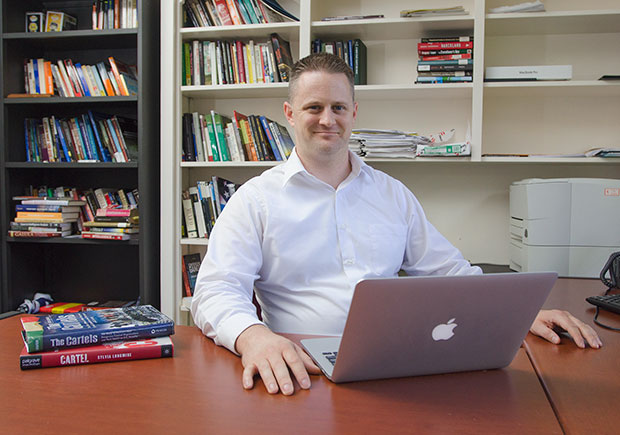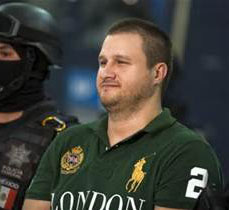Today@Sam Article
CJ Prof Explores Drug Cartels From 'Inside'
June 17, 2015
SHSU Media Contact: Beth Kuhles
 |
| One of the College of Criminal Justice's Department of Security Studies' newest professors, Nathan Jones brings experience and expertise in topics that include border security, homeland security and transnational violence networks such as drug cartels. —Photos by Brian Blalock |
As a doctoral student studying drug cartels in Mexico, Nathan Jones was given the nickname “La Barbie” after an American who became a Mexican drug lord and wound up as a snitch. The locals were convinced the young, clean-cut student was a CIA or FBI agent, though “La Barbie” was actually a Mexican-American named Edgar Valdez Villarreal, whom Jones admits does look like a heavier version of himself.
As a dissertation fellow with the Institute for Global Conflict and Cooperation, Jones travelled to Mexico City, where he interviewed high-level officials about the fight against the Arellano Felix cartel, and to Tijuana, where he spoke to local police, business leaders, and state officials about the impact of the cartel in the community.
Now an assistant professor at Sam Houston State University, teaching undergraduate and graduate students in the Department of Security Studies, Jones brings the topics—including border security, homeland security and transnational violence networks—to life through his experiences and his perspective resulting therefrom.
“The College of Criminal Justice is amazing and we have some amazing students,” Jones said.
Jones's research compared the American and Mexican responses to the drug cartel and concluded that both countries had differing views on the structure of the organization because they were examining different parts of the same cartel.
While conducting his research in Mexico, wherever Jones went, his nickname—and false impressions—went with him.
 |
| Nathan Jones (below) acquired the nickname "La Barbie" while he conducted his research in Mexico because of his resemblance to Edgar Valdez Villarreal (above), the real "La Barbie," a Mexican drug lord who wound up as a snitch. |
 |
In Mexico City, while his landlord was installing a lock on his apartment to prevent petty theft, Jones was bitten by his dog. The landlord feared retribution because he believed his dog bit an FBI agent.
During a meeting over coffee with Mexican politicians, they jokingly asked him to do a “flip,” “so we can see the listening devices fall out of my pockets.”
“People thought I was a FBI or CIA agent,” Jones said. “I am not, nor have I ever been. People also thought I was military, but I am just an academic interested in drug cartels.”
Jones regularly witnessed the aftermath of drug violence on Mexican streets and bullet holes in Tijuana where police were killed in gun battles. One day, a non-descript white van suddenly lit up with lights and sirens, and Jones didn’t know if the van was occupied by police or cartel leaders.
Despite the evidence of violence, Jones only experienced one unnerving incident.
A few days after giving an interview on his work to National Public Radio in San Diego, he was suddenly pulled over by an 18-year-old soldier at an army checkpoint and approached tactical-style with a 9 mm and AR-15 rifle.
While Jones admits he was speeding, he still doesn’t know if it was because of the media interview or if they viewed him as an American crossing the border for drugs or prostitution.
In his research, Jones has been able to document the U.S. and Mexican responses to the cartels, with each project addressing the same problem from a different perspective. Mexican authorities saw the organization as a flat structure, because they looked at high-level leaders in the Columbian cartel, whereas, the U.S. saw it as a hierarchical structure, because they were looking at drugs coming into the country and considered the levels of management needed for the cartels to get them here.
Jones also saw how Operation United Eagle—wherein fugitive operation teams were vetted and trained in the U.S. and returned to Mexico to capture leaders—was successful in making high-level arrests because it required teams to cut off communications with their families, thus eliminating threat to the mission that might come from kidnapping family members.
In addition, Jones witnessed the impact local citizens had on the cartel in fighting the kidnapping and murder of citizens in Tijuana, which led to a split in Arellano Felix that ultimately led to its demise.
“I had a very enjoyable time in Mexico,” Jones said. “I loved the Mexican culture, and I improved my Spanish significantly. I think it is important to have an on-the-ground sense of what is going there. I respect the different methods used in research, and I believe it can be quantitative or qualitative. It all brings something to the table.”
After graduating from the University of California in Irvine, Jones was accepted for a post-doctoral fellowship at the Baker institute at Rice University, where he worked on drug policies and wrote the proposal for the Mexico Center, a $1.8 million grant to fund a project that looked at improving relations between Mexico and the U.S. in many fields, including energy reform. Jones started the Baker Institute Viewpoint, a blog that featured experts on policy-related issues and also wrote policy memos on issues involving Tijuana.
- END -
This page maintained by SHSU's Communications Office:
Director of Content Communications: Emily Binetti
Communications Manager: Mikah Boyd
Telephone: 936.294.1837
Communications Specialist: Campbell Atkins
Telephone: 936.294.2638
Please send comments, corrections, news tips to Today@Sam.edu
